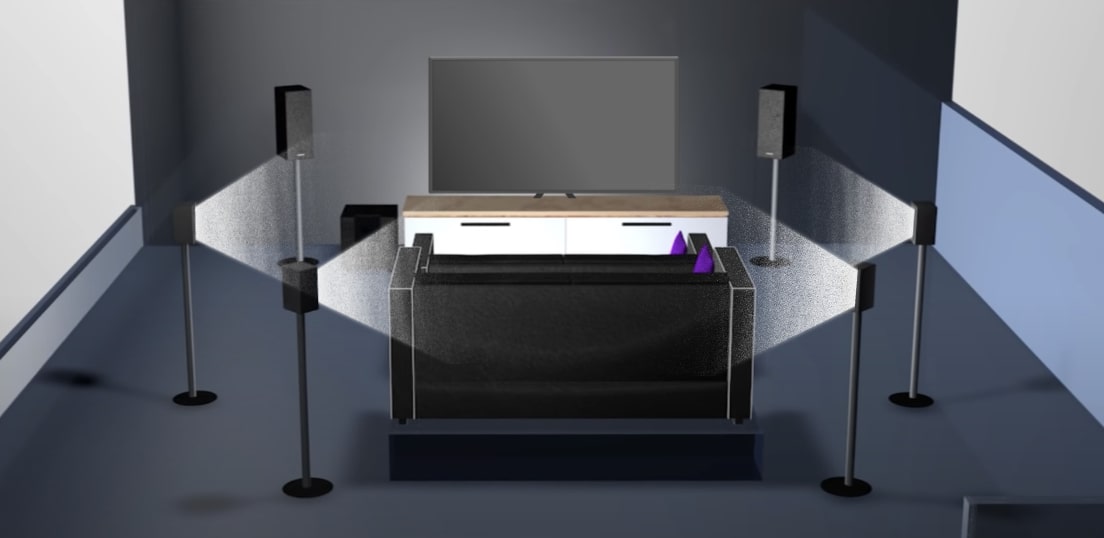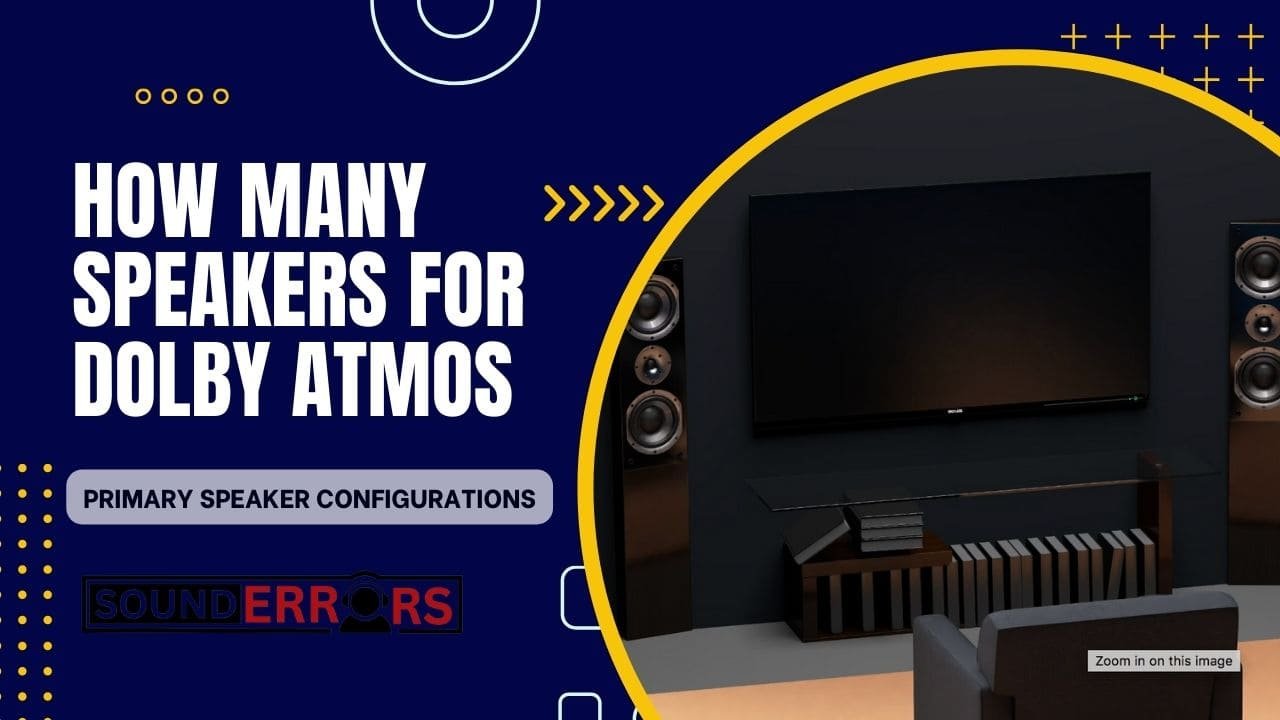This Post may contain affiliate links, when you purchase through links on our site, we may earn an affiliate commission at no extra cost to you. Here’s how it works.
In the ever-evolving audio technology, Dolby Atmos has emerged as a revolutionary system that transports audiences into a three-dimensional audio experience.
Table of Contents
ToggleRenowned for its ability to create a lifelike soundscape, Dolby Atmos has left enthusiasts wondering about the ideal speaker setup to harness its true potential.
In this article, we’ll explore the intricacies of Dolby Atmos and delve into the question: how many speakers for Dolby atmos?
So, without wasting any more crucial time, let us delve into our topic in detail.
How Many Speakers Are Required for Dolby Atmos?
Dolby Atmos configurations vary, ranging from 5.1.2 to more elaborate setups like 11.1.6.
The number of speakers required depends on the level of immersion you seek and the size of your entertainment space.
A basic 5.1.2 setup includes five main speakers, a subwoofer, and two height speakers, while more elaborate configurations incorporate additional surround and overhead channels for a more comprehensive audio experience.

How Many Speakers for Dolby Atmos Home Theater?
When building a Dolby Atmos home theatre, the speaker configuration is a critical consideration.
For smaller rooms, a 5.1.2 or 7.1.2 setup may suffice, offering a captivating surround sound experience.
Larger home theaters or dedicated entertainment spaces may benefit from 9.1.4 or 11.1.6 configurations, ensuring that the audio fills the space adequately, delivering a truly cinematic experience.
Which Type of Speaker Supports Dolby Atmos?
Dolby Atmos is compatible with various speaker types, each serving a specific purpose in the audio system. These include:
- Main Speakers: Responsible for delivering primary audio, including dialogue, music, and ambient sounds. Can be floor-standing, bookshelf, or wall-mounted.
- Subwoofer: Handles low-frequency sounds, adding depth and impact to the overall audio experience. Placed strategically for optimal bass response.
- Height Speakers: Dedicated to creating the vertical element in Dolby Atmos. Can be in-ceiling speakers, upward-firing modules, or dedicated height speakers mounted on the walls.
- Surround Speakers: Enhance the sense of space and envelopment. Positioned to the sides and rear, these speakers contribute to a 360-degree soundstage.
- Overhead Speakers: Integral for delivering the immersive overhead effects in Dolby Atmos. Installed in-ceiling or through the use of upward-firing modules.
Primary Speaker Configurations:
5.1.2 Setup:
- This configuration comprises a standard 5.1 surround sound setup (front left, front center, front right, rear left, and rear right speakers) along with two overhead or height speakers. The ‘2’ in 5.1.2 indicates the two height channels, which are crucial for creating a sense of verticality in the audio.
7.1.2 Setup:
- Building upon the 5.1.2 configuration, the 7.1.2 setup includes two additional surround speakers, creating a more comprehensive surround sound experience. The primary speakers remain the same, but the extra surrounds contribute to a more enveloping audio atmosphere.
9.1.4 Setup:
- Stepping up the game, the 9.1.4 configuration incorporates nine main speakers (front left, front center, front right, rear left, rear right, and four surrounds) and four overhead speakers. This arrangement is ideal for larger spaces, providing an expansive and detailed Dolby Atmos experience.
11.1.6 Setup:
- For the ultimate home theater enthusiasts, the 11.1.6 configuration boasts eleven main speakers and six overhead speakers. This setup is designed for dedicated home theaters or large entertainment spaces, delivering unparalleled audio immersion.
Speaker Types for Dolby Atmos
▶ Main Speakers Unveiled:
Main speakers play a pivotal role in any audio setup, serving as the primary source for dialogue, music, and ambient sounds.
The choice of main speakers in a Dolby Atmos configuration depends on various factors such as room size, personal preferences, and the overall audio experience you aim to achieve.
- Floor-Standing Speakers:
- Description: These speakers are standalone units that rest directly on the floor. They are known for delivering robust and full-range audio, making them suitable for larger rooms.
- Advantages: Provide powerful, impactful sound; often features multiple drivers for a wide frequency range.
- Considerations: Require more floor space; ideal for dedicated home theaters or larger living rooms.
- Bookshelf Speakers:
- Description: Compact and versatile, bookshelf speakers are designed to be placed on elevated surfaces like shelves or speaker stands. They offer a balance between size and performance.
- Advantages: Space-efficient; suitable for smaller rooms; can be paired with a subwoofer for enhanced bass.
- Considerations: May not produce as much bass as floor-standing speakers; positioning on stable surfaces is crucial.
- Wall-Mounted Speakers:
- Description: Designed to be mounted on walls, these speakers save floor space and contribute to a clean, minimalist aesthetic.
- Advantages: Space-saving; customizable placement; suitable for smaller rooms or situations where floor space is limited.
- Considerations: Mounting considerations for optimal sound projection may not deliver the same bass response as more prominent speakers.
▶ Subwoofers: The Heartbeat of Bass:
Subwoofers are essential components of any Dolby Atmos system, responsible for handling low-frequency sounds and adding depth to the audio experience.
Understanding their role and placement is crucial for achieving balanced and impactful bass.
- Placement Strategies:
- Strategic Corners: Placing the subwoofer in a corner of the room can enhance bass response due to room acoustics. However, it may lead to uneven bass distribution.
- Subwoofer Crawl: A technique where you physically crawl around the room to find the optimal position where the subwoofer delivers the most balanced and resonant bass.
- Impact on Low-Frequency Sound Reproduction:
- Enhanced Cinematics: Subwoofers contribute to the rumbling effects in movies, enhancing the cinematic experience by reproducing the deep, visceral sounds of explosions, thunder, and more.
- Music Enjoyment: In music, subwoofers add richness to low-frequency instruments like drums and enhance the overall musical experience.
Conclusion-
In the realm of Dolby Atmos, determining how many speakers for Dolby Atmos you need ultimately hinges on factors such as your available space, budget constraints, and the desired level of auditory immersion.
Whether you choose a modest 5.1.2 setup or commit to the expansive 11.1.6 configuration, the crucial aspect is to customize your speaker arrangement to align seamlessly with the distinctive characteristics of your home theatre.
Hopefully, this article has been helpful to you. Please help us to spread the word about it.
